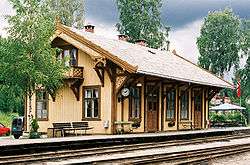Georg Andreas Bull
| Georg Andreas Bull | |
|---|---|
 | |
| Born |
26 March 1829 Bergen, Norway |
| Died | 1 February 1917 (aged 87) |
| Nationality | Norwegian |
| Occupation | Architect |
Georg Andreas Bull (26 March 1829 – 1 February 1917) was a Norwegian architect and chief building inspector in Christiania for forty years. He was among the leading architects in the country, and left his mark on Norwegian building history both as a creative architect, and through his measurement studies and archeological research.[1]
Personal life
Bull was born in Bergen, as a son of pharmacist Johan Storm Bull and his wife Anna Dorothea Borse Geelmuyden. He was a brother of violinist Ole Bull and painter Knud Bull,[1] an uncle of Edvard Hagerup Bull and Schak Bull, a granduncle of Sverre Hagerup Bull and a second cousin of Johan Randulf Bull and Anders Sandøe Ørsted Bull.[2]
He was married to Emilie Constance Hjelm, and father of architect Henrik Bull. He had nine children, and died in Bestum in Ullern in 1917.[1]

Career
Bull received drawing lessons in Bergen by the German architect and painter Franz Wilhelm Schiertz from 1843 to 1845. He then studied machine engineering at the Polytechnische Schule in Hannover from 1846 to 1850, and continued his studies in England. After his engineering studies he made archeological studies of the Haakon's Hall in Bergen, other buildings from the Middle Ages, including 20 stave churches. He studied architecture at the Berliner Bauakademie from 1855 to 1856. He started working as an architect in Kristiania in 1857, where his first significant work was Christiania Dampkjøkken. After a major fire in Kristiania in 1858 he started planning the villa area Homansbyen, where he also designed many of the buildings, during the period from 1858 to 1866. He was architect for Statsbanene from 1863 to 1872.[1]
Bull's designs ranged from churches, villas and train stations to interiors and storehouses. Among his works are the two train stations in Oslo, Oslo Vestbanestasjon and Østbanen, and altogether about sixty train stations throughout the country.[1] He designed railway stations of the Krøder Line, including the Krøderen Station (1872), and of the Grensebanen, including Åbogen Station (1865), Matrand Station (1865) and Magnor Station (1865).[3]
Bull was a board member of the Society for the Preservation of Ancient Norwegian Monuments from 1853 to 1864, and of Christiania Theatre from 1866. He was chairman for Selskabet for Christiania Byes Vel from 1904 to 1908. He was decorated Knight, First Class of the Royal Norwegian Order of St. Olav in 1875, and was decorated Knight of the Order of the Dannebrog.[1]
References
- 1 2 3 4 5 6 Torvanger, Åse Moe. "Georg Andreas Bull". In Helle, Knut. Norsk biografisk leksikon (in Norwegian). Oslo: Kunnskapsforlaget. Retrieved 20 April 2009.
- ↑ Bratberg, Terje (2007). "Den trønderske slekten Bull". In Henriksen, Petter. Store norske leksikon (in Norwegian). Oslo: Kunnskapsforlaget. Retrieved 4 April 2009.
- ↑ Steigan, Geir Tandberg. "Georg Andreas Bull (1829-1917)" (in Norwegian). Arc!. Retrieved 23 April 2009.
External links
| Wikimedia Commons has media related to Georg Andreas Bull. |